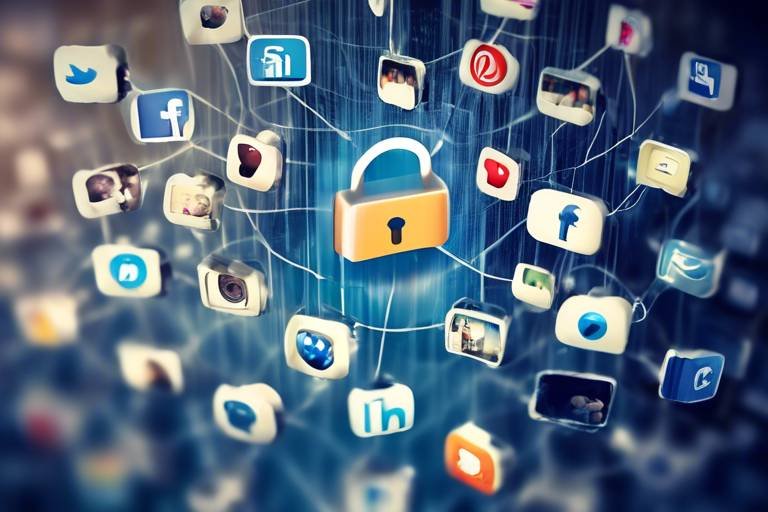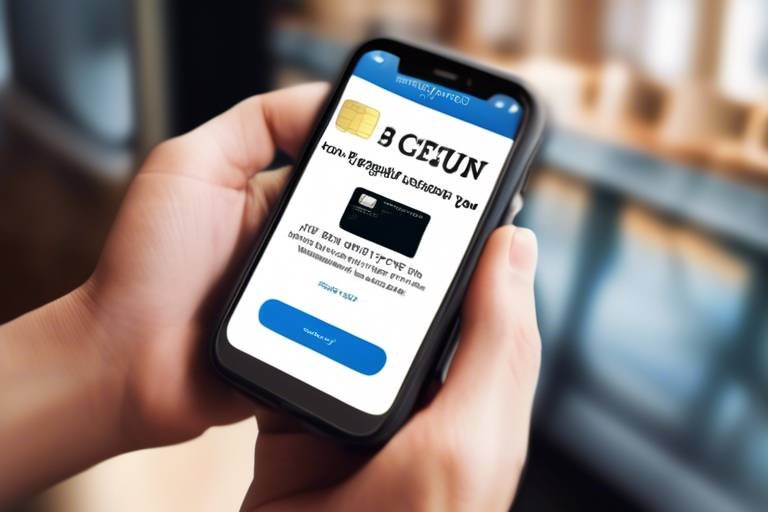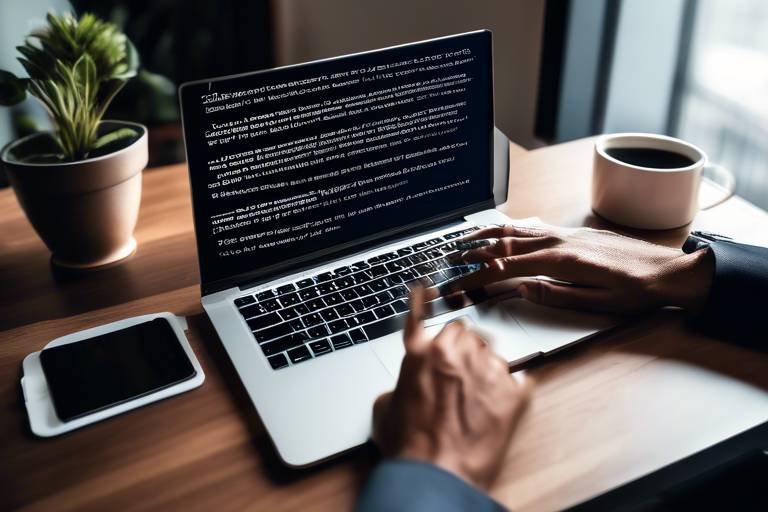How to Secure Your Data on Social Networking Sites
In today's digital age, social networking sites have become an integral part of our daily lives. They allow us to connect with friends, share experiences, and even promote our businesses. However, while these platforms offer numerous benefits, they also pose significant risks to our personal data. With increasing reports of data breaches and privacy violations, securing your information on social media has never been more crucial. In this article, we will explore effective strategies to safeguard your personal information on social media platforms, ensuring a safer online experience while maintaining your digital presence.
One of the first steps in protecting your data on social networking sites is to familiarize yourself with the privacy settings available on each platform. These settings allow you to control who can see your posts, profile information, and other personal details. For instance, platforms like Facebook and Instagram offer options to make your account private, which means only approved followers can view your content. Take the time to explore these settings and customize them according to your preferences. It’s like locking the doors to your home; you wouldn’t leave them wide open for anyone to walk in, right?
Another critical aspect of securing your social media accounts is the creation of strong, unique passwords. A common mistake many users make is using easily guessable passwords or the same password across multiple sites. This is akin to using the same key for your house, car, and office; if someone gets hold of that key, they have access to everything! To create a strong password, consider the following tips:
- Use a mix of uppercase and lowercase letters, numbers, and special characters.
- Avoid using personal information such as birthdays or names.
- Make your password at least 12 characters long.
Managing multiple strong passwords can be overwhelming, but that's where password managers come into play. These tools can generate complex passwords for you and store them securely, so you don’t have to remember each one. Think of a password manager as a safe where you keep all your valuable keys. It not only simplifies your life but also enhances your overall security on social networking sites.
When selecting a password manager, look for features like encryption, user reviews, and compatibility with your devices. Some popular options include LastPass, 1Password, and Bitwarden. Choose one that fits your needs and offers robust security features to keep your data safe.
It’s essential to understand the necessity of updating your passwords regularly. Just as you wouldn’t wear the same clothes every day, you shouldn’t use the same passwords indefinitely. Regular updates minimize the risk of unauthorized access to your accounts. Set a reminder to change your passwords every few months, and you’ll significantly enhance your security.
Enabling two-factor authentication (2FA) is another effective way to secure your social media accounts. This feature adds an extra layer of security by requiring not only your password but also a second form of verification, such as a code sent to your phone. It’s like having a bouncer at the door of your digital space. Even if someone manages to steal your password, they won’t be able to access your account without that second verification step.
Phishing scams are rampant on social media, with cybercriminals using various tactics to trick users into revealing personal information. Be on the lookout for suspicious messages or links that ask for sensitive data. If something feels off, trust your instincts. It’s always better to be safe than sorry. Educate yourself on common phishing tactics, such as fake friend requests or messages that create a sense of urgency.
If you encounter suspicious messages or accounts, it’s crucial to report them to the platform immediately. This action not only helps protect you but also safeguards other users from potential threats. Social media platforms take these reports seriously and often investigate promptly, contributing to a safer online environment for everyone.
Many social networking sites allow third-party applications to connect to your account, which can be convenient but also risky. It's essential to review and manage the permissions granted to these apps regularly. Some may have access to more data than you realize, leading to potential data leaks. Take the time to audit your connected apps and remove any that you no longer use.
Revoking access from applications you no longer use is a straightforward process. Simply navigate to your account settings and find the section dedicated to app permissions. From there, you can easily remove any apps that are no longer relevant, reducing the risk of data exposure.
Using public Wi-Fi networks to access your social media accounts can be risky. Cybercriminals often exploit these networks to intercept data. If you must use public Wi-Fi, consider using a VPN to encrypt your connection. It’s like putting on a disguise while you’re out in public—helping to keep your information safe from prying eyes.
Lastly, staying informed about data privacy laws and best practices is crucial. Knowledge is power, and understanding how to protect your information on social networking sites can significantly enhance your security. Follow reliable sources, read articles, and keep yourself updated on the latest trends in data privacy. Remember, the more you know, the better you can protect yourself!
Q: How can I tell if my account has been hacked?
A: Look for unusual activity, such as messages you didn’t send or changes to your profile. If you notice anything suspicious, change your password immediately.
Q: Is it safe to use the same password for different accounts?
A: No, using the same password across multiple accounts increases the risk of a security breach. Always use unique passwords.
Q: What should I do if I receive a suspicious message?
A: Do not click on any links or provide personal information. Report the message to the platform and delete it.
Q: How often should I update my passwords?
A: It’s recommended to update your passwords every three to six months to ensure your accounts remain secure.

Understanding Privacy Settings
In the digital age, where sharing has become second nature, understanding privacy settings on social networking sites is crucial. Think of your social media profile as your personal garden; you wouldn't want just anyone trampling through it, right? By mastering these privacy controls, you can dictate who gets to peek into your life and what information is shared with the world. Each platform has its own unique set of privacy features, and navigating through them can sometimes feel like deciphering a secret code. But don’t worry; once you get the hang of it, you'll be able to cultivate a safe online presence.
First things first, let’s take a look at some common features you’ll find across various platforms:
| Social Media Platform | Privacy Settings Features |
|---|---|
| Profile visibility, friend requests, post visibility, and location sharing. | |
| Account privacy (public or private), story visibility, and comment controls. | |
| Tweet privacy, direct message settings, and follower management. |
When you dive into your privacy settings, start by asking yourself: Who do I want to see my posts? For instance, on Facebook, you can choose between options like 'Public,' 'Friends,' or 'Only Me' for each post. If you’re sharing something personal, it’s wise to limit visibility to just your friends. On Instagram, switching your profile to private means only approved followers can see your content, ensuring that your photos are shared only with those you trust.
Moreover, be vigilant about your friend requests. It might be tempting to accept every request that comes your way, but remember that not everyone has good intentions. If someone you don’t know sends you a friend request, take a moment to check their profile. Are they a real person or just a bot? Protecting your online space is about being proactive.
Another essential aspect of privacy settings is understanding how your information is shared with third-party apps. Many social networks allow you to connect with other applications, which can be fun but also risky. Always review the permissions you’ve granted to these apps. If an app is asking for more access than it needs, it’s a red flag. You might want to consider revoking access to apps that you no longer use or trust.
In summary, mastering your privacy settings is akin to having a strong lock on your front door. It’s not foolproof, but it significantly reduces the chances of unwanted intrusions. By taking the time to understand and adjust these settings, you're not just protecting your information; you're also enhancing your overall online experience. So, roll up your sleeves and get to work on your privacy settings—you'll be glad you did!
- How often should I review my privacy settings? It's a good practice to review your settings every few months or whenever there's a major update from the platform.
- Can I customize who sees specific posts? Yes, most platforms allow you to customize visibility for each post individually.
- What should I do if I suspect someone is misusing my information? Report the issue to the platform and consider adjusting your privacy settings to limit access.

Creating Strong Passwords
In today's digital landscape, where our lives are increasingly intertwined with social media, the importance of cannot be overstated. Think of your password as the key to your digital home; if it’s weak, you’re inviting intruders in. A strong password acts as a barrier, protecting your personal information from cybercriminals who are always on the prowl. But what constitutes a strong password? Let’s dive into the essential elements that make up a resilient password.
First and foremost, a strong password should be at least 12 to 16 characters long. The longer your password, the harder it is for someone to crack it. It’s like building a fortress; the more walls you have, the more difficult it is to breach. Additionally, your password should include a mix of uppercase and lowercase letters, numbers, and special characters. This combination not only enhances security but also makes it less predictable. For instance, instead of using a simple word like "password," consider a phrase like "MyD0g$Barks@Night!" which is much harder to guess.
Another vital aspect is to avoid using easily obtainable information, such as your name, birthday, or common words. Cybercriminals often use social engineering tactics to gather this information and can easily guess passwords based on it. Instead, think of using a passphrase—a sequence of random words that create a memorable yet complex password. For example, "BlueSky!Dances@UnderMoon" is not only unique but also easier to remember than a random string of characters.
Now, let’s talk about the importance of password management. With so many accounts requiring unique passwords, it can be challenging to remember them all. This is where password managers come into play. They can securely store your passwords and even generate complex ones for you. This way, you don’t have to rely on memory alone, and you can ensure each account has a unique password. It’s like having a vault that holds all your keys securely.
Lastly, it’s crucial to regularly update your passwords. Think of it as changing the locks on your doors periodically. Even the strongest passwords can become compromised over time, especially if a data breach occurs. Set a reminder to change your passwords every few months, and always update them immediately if you suspect any suspicious activity on your accounts.
In summary, creating strong passwords is a fundamental step in securing your social media accounts. By using a mix of characters, avoiding personal information, employing password managers, and regularly updating your passwords, you can significantly enhance your online security. Remember, a strong password is your first line of defense against cyber threats!
- What makes a password strong? A strong password is at least 12 characters long, includes a mix of uppercase and lowercase letters, numbers, and special characters, and avoids easily obtainable information.
- How often should I change my passwords? It is recommended to change your passwords every three to six months or immediately if you suspect any suspicious activity.
- Can I use the same password for multiple accounts? It’s best to use unique passwords for each account to minimize the risk of multiple accounts being compromised if one password is hacked.
- What is a password manager? A password manager is a tool that securely stores and manages your passwords, helping you generate strong passwords and keeping them safe.

Utilizing Password Managers
In today's digital age, where our lives are intertwined with technology, the importance of strong passwords cannot be overstated. But let's be honest: remembering all those complex passwords can feel like trying to juggle flaming torches while riding a unicycle! This is where password managers come into play, acting as your personal vault for all your login credentials. They not only store your passwords securely but also generate complex passwords that make it nearly impossible for hackers to crack them.
Imagine having a single master password that unlocks a treasure chest filled with all your unique passwords. That's the magic of a password manager! With just one password to remember, you can easily access all your accounts without the headache of recalling multiple combinations. Plus, these tools often come with features that allow you to automatically fill in your credentials on websites, saving you precious time and effort.
But what exactly makes password managers a must-have for anyone serious about online security? Here are some compelling benefits:
- Enhanced Security: Password managers encrypt your data, making it nearly impossible for anyone to steal your passwords.
- Convenience: They streamline the login process, allowing you to access your accounts quickly without fussing over forgotten passwords.
- Regular Updates: Many password managers remind you to update your passwords regularly, ensuring your accounts remain secure.
When choosing a password manager, it’s crucial to consider factors such as security features, ease of use, and cross-platform compatibility. Look for options that offer two-factor authentication and strong encryption methods. It's like having a double lock on your front door—extra protection never hurts!
In conclusion, utilizing a password manager not only simplifies your online experience but also significantly enhances your security. So, if you haven't yet embraced this technology, now is the time to take the plunge. Your digital life will thank you!
Q: Are password managers safe to use?
A: Yes, reputable password managers use strong encryption methods to secure your data. However, it's essential to choose a trusted provider.
Q: Can I access my passwords from multiple devices?
A: Most password managers offer cross-platform support, allowing you to access your passwords from various devices, including smartphones and computers.
Q: What if I forget my master password?
A: Many password managers have recovery options, such as security questions or backup codes, to help you regain access.

Choosing the Right Password Manager
When it comes to safeguarding your online accounts, selecting the right password manager can feel like finding a needle in a haystack. With so many options available, how do you choose the one that fits your needs best? The right password manager should not only store your passwords securely but also offer features that enhance your overall online security. Here are some key factors to consider:
- Security Features: Look for a password manager that uses strong encryption methods to protect your data. AES-256 bit encryption is the gold standard. Additionally, features like two-factor authentication (2FA) can add an extra layer of security.
- User-Friendly Interface: A password manager should be easy to navigate. If it feels complicated, you might not use it as often as you should. Test out a few options to see which interface feels the most intuitive.
- Cross-Platform Compatibility: Ensure that the password manager you choose works seamlessly across all your devices—be it a smartphone, tablet, or computer. This way, you can access your passwords anytime, anywhere.
- Backup and Recovery Options: Accidental deletions happen. A good password manager should provide a way to recover lost passwords or restore your vault in case of an emergency.
- Cost: While many password managers offer free versions, premium options often come with additional features. Assess your budget and decide if the extra features are worth the investment.
To help you make an informed decision, consider creating a comparison table of popular password managers. Here’s a quick overview:
| Password Manager | Security Features | Price | Cross-Platform |
|---|---|---|---|
| LastPass | AES-256 bit encryption, 2FA | Free / Premium $3/month | Yes |
| 1Password | AES-256 bit encryption, 2FA | $2.99/month | Yes |
| Dashlane | AES-256 bit encryption, 2FA | Free / Premium $4.99/month | Yes |
| Bitwarden | AES-256 bit encryption, 2FA | Free / Premium $10/year | Yes |
In conclusion, choosing the right password manager is an essential step in protecting your online identity. By evaluating the features that matter most to you, comparing options, and considering your budget, you can find a solution that not only keeps your passwords safe but also simplifies your digital life. Remember, a password manager is like a vault for your online credentials—make sure it’s one you can trust!

Regularly Updating Passwords
In the ever-evolving landscape of cybersecurity, regularly updating your passwords is not just a good practice; it's a necessity. Think of your password as the key to your digital home. If you never change the locks, it becomes easier for intruders to get in. Just like you wouldn't want to leave your front door open, you shouldn't leave your online accounts vulnerable either. Regular updates can thwart potential threats and keep your personal information safe from prying eyes.
So, how often should you change your passwords? Experts generally recommend updating them every three to six months. However, if you suspect that your account has been compromised or if a service you use has experienced a data breach, you should change your password immediately. It's like putting on a new lock after losing your key; it gives you peace of mind.
When updating your passwords, it’s essential to avoid common pitfalls. Here are some tips to consider:
- Avoid predictable patterns: Using '123456' or 'password' is like leaving your door wide open. Choose something unique and complex.
- Use a mix of characters: Incorporate uppercase letters, lowercase letters, numbers, and special characters. This makes it difficult for anyone to guess.
- Don't reuse passwords: Each account should have a different password. If one gets compromised, the others remain secure.
To make the process of updating passwords easier, consider using a password manager. These tools can help generate strong passwords and remind you when it’s time to update them. It’s like having a personal assistant who keeps track of all your keys, ensuring that they are always secure and updated.
Remember, the goal is to minimize the risk of unauthorized access to your accounts. By regularly updating your passwords and following best practices, you can significantly enhance your security on social networking sites. It’s a small effort that can lead to big rewards in protecting your personal information.
Q: How often should I update my passwords?
A: It's recommended to update your passwords every three to six months, or immediately if you suspect a breach.
Q: What makes a strong password?
A: A strong password includes a mix of uppercase and lowercase letters, numbers, and special characters, and should not be easily guessable.
Q: Can I use the same password for multiple accounts?
A: No, it's best to use unique passwords for each account to prevent a breach in one account from compromising others.
Q: How can a password manager help?
A: A password manager can generate complex passwords, store them securely, and remind you when to update them.

Two-Factor Authentication
In today's digital landscape, two-factor authentication (2FA) has emerged as a crucial line of defense against unauthorized access to our social media accounts. Think of it as a double lock on your front door; even if someone has the key (your password), they still need a second key to get inside. This extra layer of security is becoming increasingly vital as cyber threats evolve and become more sophisticated. So, how does 2FA work, and why should you enable it on your accounts?
When you activate two-factor authentication, you are required to provide two forms of verification before gaining access to your account. Typically, this involves something you know (your password) and something you have (like a smartphone app that generates a time-sensitive code). This means that even if a hacker manages to steal your password, they still won't be able to access your account without the second factor. It's like needing both a key and a secret code to enter a high-security vault!
Many social media platforms offer various methods for 2FA, including:
- SMS Codes: A text message is sent to your phone with a verification code each time you log in from a new device.
- Authenticator Apps: Apps like Google Authenticator or Authy generate time-sensitive codes that you enter during the login process.
- Email Verification: A code is sent to your registered email address, which you must enter to complete the login.
While enabling two-factor authentication requires a bit more effort to log in, the peace of mind it brings is invaluable. Imagine the relief of knowing that even if your password is compromised, your account remains secure. However, it’s essential to choose a method that works best for you. Some users prefer the convenience of SMS codes, while others may opt for the enhanced security of authenticator apps.
It's also important to remember that two-factor authentication is not foolproof. Cybercriminals are continually finding new ways to bypass security measures, so it’s wise to stay vigilant. Here are a few tips to enhance your two-factor authentication experience:
- Always keep your recovery codes in a safe place in case you lose access to your authentication method.
- Regularly review your account activity and be on the lookout for any unauthorized logins.
- Consider using a hardware security key for an additional layer of security, especially for sensitive accounts.
In conclusion, enabling two-factor authentication on your social media accounts is a simple yet effective way to bolster your online security. By adding this extra layer of protection, you significantly reduce the risk of unauthorized access and protect your personal information from prying eyes. So, take a moment today to enable 2FA and give yourself the peace of mind you deserve!
Frequently Asked Questions
1. What if I lose my phone and can’t access my two-factor authentication method?
If you lose your phone, many platforms provide backup codes when you set up 2FA. Keep these codes in a secure place, as they can help you regain access to your account.
2. Can I use two-factor authentication on all social media platforms?
Most major social media platforms support 2FA, including Facebook, Twitter, Instagram, and LinkedIn. Check the security settings of each platform to enable it.
3. Is two-factor authentication completely secure?
While 2FA significantly enhances security, no system is entirely foolproof. Always combine it with strong passwords and regular account monitoring for the best protection.

Recognizing Phishing Attempts
In today's digital age, being aware of phishing attempts is crucial for protecting your personal information on social media. Phishing is a deceptive tactic used by cybercriminals to trick you into revealing sensitive data, such as passwords or credit card numbers. These scams often come disguised as legitimate messages, making it easy for even the most cautious users to fall victim. So, how can you spot these sneaky attempts? Let’s break it down.
First and foremost, always be on the lookout for unusual messages. If you receive a message from a friend that seems out of character or contains a suspicious link, think twice before clicking. Cybercriminals often hack accounts and send messages to the victim's contacts, hoping someone will unwittingly click on a malicious link. Trust your instincts; if something feels off, it probably is.
Another common tactic is the use of urgent language. Phishing messages often create a sense of urgency, pushing you to act quickly without thinking. For example, you might receive a notification claiming that your account will be suspended unless you verify your identity immediately. Always take a moment to breathe and assess the situation. Legitimate companies will not pressure you into making hasty decisions.
Moreover, be wary of messages that contain generic greetings instead of your name. Phishing attempts frequently use phrases like "Dear Customer" or "Hello User" rather than personalizing the message with your actual name. This is a red flag that the message may not be from a legitimate source.
Additionally, pay attention to the URLs in the messages you receive. Cybercriminals often create fake websites that look like the real deal. Before clicking on any links, hover over them to see the actual URL. If it seems suspicious or doesn’t match the official site, do not click. Here’s a quick table to help you identify the characteristics of a phishing URL:
| Indicator | What to Look For |
|---|---|
| Misspellings | Check for typos in the URL like "facebo0k.com" instead of "facebook.com". |
| Unusual Domain Extensions | Be cautious of unfamiliar domain endings like ".xyz" or ".info". |
| Extra Characters | Look for additional characters or subdomains, such as "login.secure-website.com". |
In addition to these tactics, always remember to report suspicious messages to the platform. Most social media sites have mechanisms in place to report phishing attempts. By doing this, you not only protect yourself but also help safeguard others from similar threats. If you suspect a message is a phishing attempt, report it immediately.
In conclusion, recognizing phishing attempts is about being vigilant and informed. By understanding the common tactics used by cybercriminals, you can better protect yourself and your personal information. Always stay alert, trust your instincts, and don’t hesitate to verify before you click. The digital world is vast, but with a little caution, you can navigate it safely.
Q: What should I do if I clicked on a phishing link?
A: If you've clicked on a phishing link, immediately change your passwords and enable two-factor authentication if possible. Monitor your accounts for any suspicious activity.
Q: How can I report phishing attempts?
A: Most social media platforms have a reporting feature. Use it to report any suspicious messages or accounts to help protect others.
Q: Are there any tools to help identify phishing attempts?
A: Yes, there are various browser extensions and security software that can help detect and warn you about potential phishing sites.

Reporting Suspicious Activity
When it comes to protecting your personal information on social media, vigilance is key. If you encounter any suspicious activity—be it a strange message from a friend, an account that seems off, or even a post that raises red flags—it's crucial to take action. Reporting suspicious activity not only helps safeguard your own data but also contributes to the safety of the broader community. You might be wondering, "How do I identify what’s suspicious?" Here are some common indicators:
- Unusual Messages: If you receive messages from friends that seem out of character or include links you weren’t expecting, be cautious.
- Fake Profiles: Accounts that mimic real people but have few friends or odd profile pictures can be a sign of phishing attempts.
- Unsolicited Friend Requests: If someone you don’t recognize tries to connect with you, especially if they claim to know mutual friends but seem vague about details, it’s a red flag.
Once you spot something suspicious, don’t hesitate to report it. Most social media platforms have a straightforward process for doing this. For instance, you can usually find a “Report” button next to posts, messages, or profiles. By reporting these activities, you help the platform take necessary actions, which can include removing harmful content or even banning malicious accounts.
Additionally, it’s essential to maintain a proactive approach. Regularly review your friend list and connections. If you notice any accounts that you don’t recognize or haven’t interacted with in a while, consider removing them. It’s like cleaning out your closet; you want to keep only what’s useful and safe. Remember, your safety online is just as important as your safety in the real world, so don’t hesitate to act when something feels off.
Furthermore, if you’re unsure whether something is worth reporting, trust your instincts. If it feels wrong, it probably is. Engaging with suspicious accounts can lead to unwanted consequences, such as malware infections or identity theft. Always err on the side of caution. By being proactive and reporting suspicious activity, you’re not just protecting yourself; you’re helping create a safer environment for everyone.
Q: What should I do if I accidentally clicked on a suspicious link?
A: Immediately change your passwords and enable two-factor authentication on your accounts. Run a security scan on your device to check for malware.
Q: How can I tell if a friend’s account has been hacked?
A: Look for unusual posts or messages that don’t sound like them, or if they start sending you unsolicited links. If you suspect hacking, reach out to your friend through a different communication method to verify.
Q: How often should I review my privacy settings?
A: It’s a good practice to review your privacy settings at least once every few months or whenever there are updates to the platform’s policies.
Q: What information should I never share on social media?
A: Avoid sharing sensitive information such as your home address, phone number, or financial details. Also, be cautious about sharing your location in real-time.

Managing App Permissions
In today’s digital landscape, social media platforms are interconnected with a myriad of third-party applications. These apps can enhance your experience, but they can also pose significant risks to your privacy if not managed properly. Think of it this way: granting permissions to an app is like giving someone the keys to your home. You wouldn't hand over your keys to just anyone, right? Similarly, you need to be cautious about which apps you allow to access your social media accounts.
First and foremost, it's essential to understand what permissions you are granting. When you connect an app to your social media account, you often provide it with access to your personal information, such as your profile details, friends list, and even your posts. This can lead to data leaks if the app is not secure or if it is misused. Therefore, regularly reviewing the permissions granted to each app is crucial. Many platforms provide a straightforward way to do this. For instance, on Facebook, you can go to Settings > Apps and Websites to see a list of all connected apps and the permissions they have.
Once you have this information, it’s time to evaluate each app critically. Ask yourself these questions: Do I still use this app?, Is it reputable?, and What data does it access? If the answers lean towards “no,” it’s time to take action. You can revoke access to any app you no longer use or trust. This not only protects your data but also helps maintain your overall digital footprint. Here’s a quick guide on how to revoke access:
- Navigate to the settings of your social media account.
- Find the section dedicated to apps or connected services.
- Review the list and click on the app you wish to remove.
- Select the option to revoke access or remove the app.
Moreover, it’s worth noting that some apps may request excessive permissions that are not necessary for their functionality. For example, a simple game app may not need access to your contacts or location. Always be wary of such requests. If you feel uncomfortable with the permissions an app is asking for, it’s best to look for alternatives that respect your privacy.
Lastly, consider keeping a record of the apps you use and their permissions. This can serve as a helpful reference in case you want to reassess your digital connections in the future. You could create a simple table to track this information:
| App Name | Permissions Granted | Last Used | Action Needed |
|---|---|---|---|
| Example App 1 | Profile, Friends List | Last Month | Keep |
| Example App 2 | Contacts, Location | Never | Remove |
In conclusion, managing app permissions is a vital step in protecting your data on social networking sites. By regularly reviewing and adjusting the permissions granted to various applications, you can significantly reduce the risk of unauthorized access to your personal information. Remember, just because an app is popular doesn’t mean it’s safe. Always prioritize your privacy!
Q: How often should I review my app permissions?
A: It’s a good practice to review your app permissions every few months, or whenever you notice a new app request.
Q: What should I do if I suspect an app is misusing my data?
A: Immediately revoke its access and report the app to the social media platform for potential violations of privacy policies.
Q: Are there any tools to help manage app permissions?
A: Some password managers and privacy tools can help track and manage app permissions across multiple platforms.

Revoking Unused Apps
In today's digital landscape, it's common to connect various third-party applications to your social media accounts for enhanced functionality. However, many of these apps can pose a risk to your personal data if left unchecked. It's crucial to regularly review and revoke access from applications that you no longer use. Think of it as spring cleaning for your digital life; just as you wouldn't keep old clothes that no longer fit, you shouldn't hold onto apps that no longer serve a purpose.
So, how do you go about revoking these unused apps? The process is relatively straightforward, but it varies slightly depending on the platform. Here's a general guide to get you started:
- Log into your social media account: Start by accessing your account on the platform where you want to manage app permissions.
- Navigate to settings: Look for the settings or privacy section, which is usually found in the dropdown menu under your profile picture.
- Find app permissions: Once you're in the settings, look for a section dedicated to app permissions or third-party apps. This is where you'll see a list of all the applications that have access to your account.
- Review the list: Take a moment to go through the apps. If you see any that you don't recognize or haven't used in a while, it's time to take action.
- Revoke access: Click on the app you wish to remove and follow the prompts to revoke its access. This action will ensure that the app can no longer access your data.
By revoking access to unused applications, you're not only protecting your personal information but also minimizing the potential for data leaks. It's a simple yet effective way to enhance your security on social media platforms. Remember, just because an app was useful at one point doesn't mean it still is. Regularly auditing your connected apps is a proactive approach to safeguarding your digital identity.
Additionally, if you're unsure about the legitimacy of an app, do a quick search online to see if others have reported issues. Trust your instincts; if something feels off, it's better to err on the side of caution. In the end, managing your app permissions is like locking the doors to your house. You wouldn't leave them wide open for just anyone to walk in, so why would you do the same with your online accounts?
Q: How often should I revoke unused apps?
A: It's a good practice to review your app permissions at least once every few months. This ensures that you're only connected to apps that you actively use.
Q: What if I accidentally revoke access to an app I still want to use?
A: No worries! You can always reconnect the app by going back to the app's website or settings and following the prompts to reconnect your social media account.
Q: Are there any apps I should never connect to my social media?
A: Be cautious with apps that ask for extensive permissions or seem suspicious. Always research apps before connecting them to your social media accounts.

Being Cautious with Public Wi-Fi
Ah, the allure of free Wi-Fi! It's like a siren's call that tempts us to connect while sipping our favorite coffee at a cozy café or waiting at the airport. But before you dive headfirst into the digital ocean of public networks, it’s crucial to understand the lurking dangers. Public Wi-Fi networks are often unsecured, making them prime hunting grounds for cybercriminals. Imagine walking through a crowded marketplace, unaware that someone is stealthily picking your pockets. That’s what using public Wi-Fi can feel like if you’re not careful.
When you connect to a public Wi-Fi network, your data can be intercepted by anyone else on that network. This means that sensitive information—like your passwords, credit card numbers, and personal messages—can be easily snatched by a malicious user. To put it simply, using public Wi-Fi without taking precautions is like leaving your front door wide open while you’re away. So, what can you do to protect yourself?
First off, consider using a Virtual Private Network (VPN). A VPN encrypts your internet connection, making it much harder for anyone to spy on your online activities. This is especially important when you're accessing sensitive information or making transactions. Think of a VPN as a secure tunnel that shields your data from prying eyes. Additionally, always ensure that the websites you visit are secure—look for URLs that start with https:// rather than just http://. The 's' at the end stands for 'secure' and indicates that the website encrypts your data.
Moreover, be cautious about what you access while on public Wi-Fi. Avoid logging into sensitive accounts, such as online banking or shopping sites, unless absolutely necessary. If you must access these accounts, ensure you are using a VPN to add that extra layer of security. It's also wise to turn off sharing features on your device when connected to public networks. This can help prevent unauthorized access to your files and personal information.
Also, consider disabling automatic connection to Wi-Fi networks. Many devices are set to automatically join open networks, which can lead you to connect to malicious hotspots that mimic legitimate networks. You wouldn’t want to accidentally walk into a trap, right? Always double-check the network name before connecting, and if the network seems suspicious, it’s better to err on the side of caution.
Finally, remember to always log out of your accounts when you’re done using them. This is a simple step that can significantly reduce the chances of someone else accessing your information. Imagine locking your car every time you step away; it’s a small effort that can save you from a lot of trouble later on.
In summary, while public Wi-Fi can be convenient, it comes with its own set of risks. By taking the necessary precautions—like using a VPN, being cautious about the sites you visit, and managing your device's settings—you can enjoy the benefits of free internet without compromising your security. So the next time you find yourself in a café with free Wi-Fi, remember to keep your digital life safe and sound!
- Is it safe to use public Wi-Fi?
Using public Wi-Fi can be risky if you don't take precautions. Always use a VPN and avoid accessing sensitive information. - What is a VPN?
A VPN, or Virtual Private Network, encrypts your internet connection, providing an additional layer of security when using public Wi-Fi. - How can I tell if a website is secure?
Look for URLs that start with https://. The 's' indicates that the website is secure. - Should I turn off sharing on my device?
Yes, turning off sharing features can help protect your personal information when connected to public networks.

Educating Yourself on Data Privacy
In today's digital world, where our lives are intertwined with social media, understanding data privacy has never been more crucial. It's not just about knowing that your information is out there; it's about taking proactive steps to protect it. Educating yourself on data privacy means diving deep into the practices and principles that govern how your information is collected, used, and shared online. Think of it as learning the rules of a game before you play—without this knowledge, you might find yourself at a disadvantage.
Data privacy encompasses various aspects, from understanding your rights as a user to knowing how to navigate the complex landscape of online regulations. For instance, did you know that laws like the General Data Protection Regulation (GDPR) in Europe and the California Consumer Privacy Act (CCPA) in the U.S. give you specific rights regarding your personal information? Familiarizing yourself with these laws can empower you to make informed decisions about your data.
Moreover, staying updated on the latest trends and threats in data privacy is essential. Cybercriminals are constantly evolving, and so are the tactics they use to exploit unsuspecting users. Regularly reading articles, attending webinars, or even joining online forums can help you stay ahead of the curve. Here are some key areas to focus on:
- Understanding Privacy Policies: Always read the privacy policies of the platforms you use. They outline how your data is collected and utilized.
- Recognizing Your Rights: Know what data you can ask companies to delete or modify.
- Staying Informed: Follow reputable sources for updates on data breaches and security tips.
Additionally, consider engaging in community discussions about data privacy. Sharing experiences and insights with others can provide valuable perspectives and enhance your understanding. Many online communities focus on data security and privacy, offering a wealth of information and support. Remember, knowledge is power, and the more you know about data privacy, the better equipped you'll be to protect your information.
Finally, don’t forget the importance of hands-on practice. Implementing what you learn about data privacy can significantly impact your online safety. Regularly review and adjust your privacy settings on social media, use strong passwords, and be vigilant about the permissions you grant to applications. By actively participating in your own data security, you become an informed and proactive user in the digital landscape.
| Question | Answer |
|---|---|
| What is data privacy? | Data privacy refers to the proper handling, processing, and usage of personal information, ensuring that individuals' data is protected from unauthorized access and misuse. |
| Why is data privacy important? | Data privacy is crucial as it helps protect individuals from identity theft, fraud, and other cyber threats, while also maintaining trust in digital interactions. |
| How can I improve my data privacy? | You can improve your data privacy by using strong passwords, enabling two-factor authentication, being cautious about sharing personal information, and regularly reviewing your privacy settings. |
Frequently Asked Questions
- How can I adjust my privacy settings on social media?
To adjust your privacy settings, go to the settings menu of your social media account. Look for the privacy section where you can control who can see your posts, who can send you friend requests, and what information is visible to the public. Make sure to review these settings regularly to keep your information secure.
- What makes a strong password?
A strong password typically includes a mix of uppercase and lowercase letters, numbers, and special characters. Aim for at least 12 characters in length and avoid using easily guessable information like birthdays or names. The more complex and unique your password, the better protected your account will be.
- Why should I use a password manager?
Password managers help you create and store complex passwords securely. They can generate unique passwords for each of your accounts, so you don’t have to remember them all. This significantly reduces the risk of using the same password across multiple sites, which can lead to security breaches.
- What is two-factor authentication and how does it work?
Two-factor authentication (2FA) adds an extra layer of security to your accounts. After entering your password, you will be prompted to provide a second form of identification—usually a code sent to your phone or email. This makes it much harder for hackers to gain access, even if they have your password.
- How can I recognize phishing attempts on social media?
Phishing attempts often come in the form of suspicious messages or links that ask for personal information. Look for signs such as poor grammar, unfamiliar sender addresses, and requests for sensitive information. If something feels off, it's best to delete the message and report it.
- What should I do if I suspect a phishing attempt?
If you suspect a phishing attempt, do not click on any links or respond to the message. Instead, report it to the social media platform and consider blocking the account. You can also inform friends to be cautious of similar messages.
- How do I manage app permissions on my social media accounts?
To manage app permissions, go to the settings section of your social media account and look for "Apps" or "Connected Apps." Here, you can review which apps have access to your information and revoke permissions for any that you no longer use or trust.
- Is it safe to use public Wi-Fi for social media?
Using public Wi-Fi can be risky because it is often unsecured, making it easier for hackers to intercept your data. If you must use public Wi-Fi, consider using a VPN to encrypt your connection and avoid accessing sensitive accounts.
- How can I stay informed about data privacy?
Staying informed about data privacy involves following reputable news sources, subscribing to privacy-focused blogs, and participating in online forums. Understanding the latest trends and legislation can help you better protect your personal information.



















